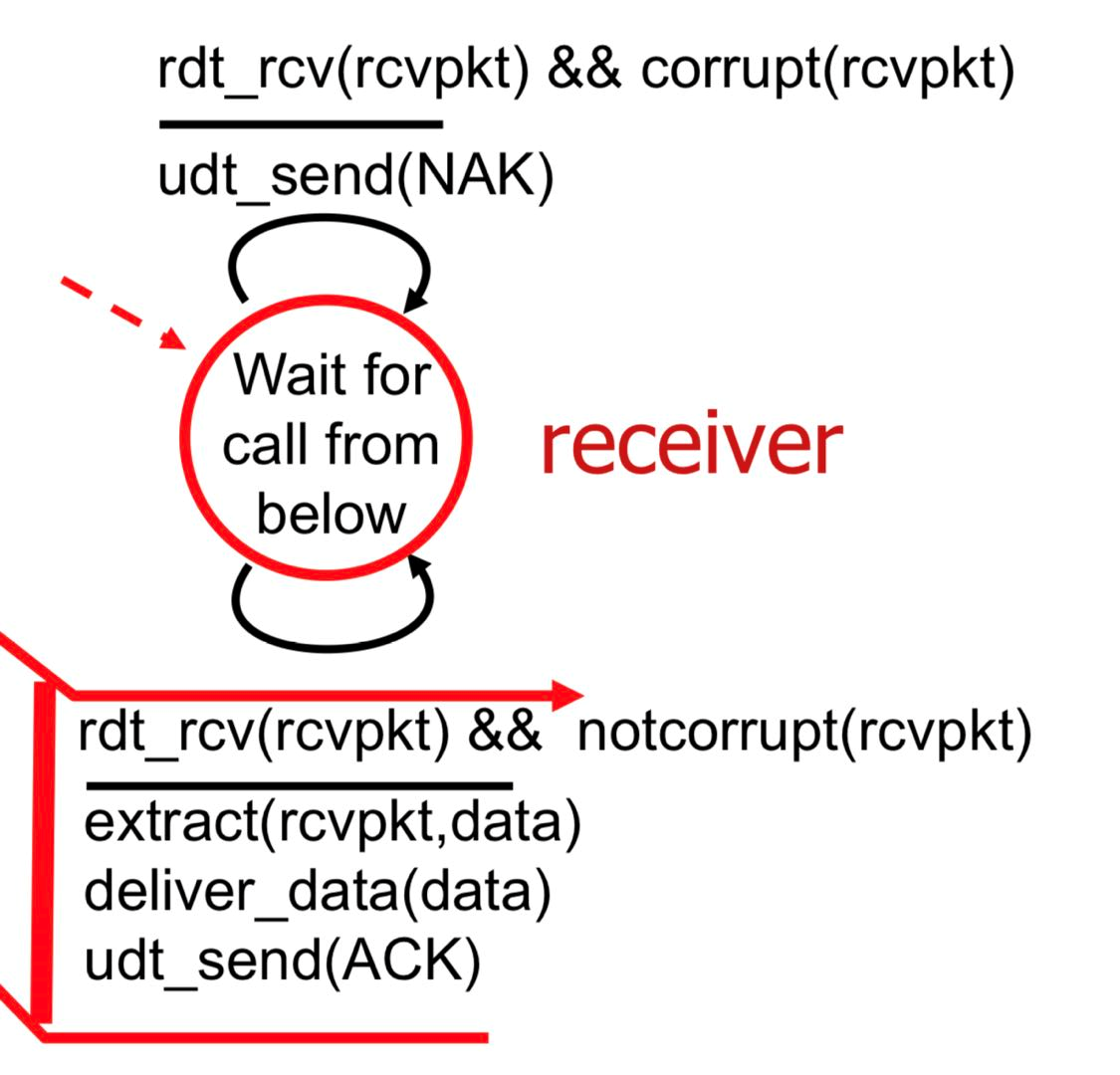Transport Layer¶
Multiplexing & Demultiplexing¶
Multiplexing at sender: handle data from multiple sockets, add transport header
Demultiplexing at receiver: use "header" info to deliver received segments to correct socket
Demultiplexing method:
- for UDP: use destination ports in segments
- for TCP: user (source IP address, source port, dest. IP address, dest port number)
UDP - Connectionless¶
Application-layer: streaming multimedia apps, DNS, SNMP, HTTP/3
Segment Format:

Checksum: 16 bits integer summation, wrap overflow bits to back
| Cons | Pros |
|---|---|
| May lost segments only best effort service | No setup/handshaking needed(no RTT incurred) can function when network service is compromised helps with reliability(checksum) little header overhead |
Road to Reliable Data Transfer¶
FSM representation of protocols¶

rdt1.0 - reliable transfer over reliable channel¶

rdt2.0 - channel with bit errors¶
Stop & wait.
Add "ACK" & "NAK" mechanism.
 |  |
|---|---|
rdt2.1 - handling ACK/NAK corruption & duplicate¶
Stop & wait.
add sequence no. (only 1-bit is enough because of stop & wait strategies)


rdt2.2 - NAK free¶
receiver sends ACK for last packet received OK (explicitly include a sequence no. #)
rdt3.0 - channels with errors and loss¶
add a reasonable timeout, retransmit package if timeout
pipelining:
Go-Back-N¶
size-n window
sender:
-
most N packets on the fly
-
cumulative ACK
- if timeout, resend whole window
receiver:
- ACK-only: always send ACK for currently received "highest" in-order seq #
Selective Repeat¶
sender & receiver has separate window.
Sender:
-
Most N package on the fly
-
only retransmit unACKed package
- timer is maintain for each packet
- forward send-window only when receive the smallest unACKed packet
Receiver:
- receive packet in the receiver-window: send ACK(n)
- Buffer!
- move the window if receive the smallest unreceived packet
Problems: ACK message may out of order, so the asynchronous between sender/receiver's window could lead to collision in seq #
Solution: seq should double the windows size(or even larger than that)
TCP - Reliable¶
- Point-to-Point: one sender and one receiver
- reliable, in-order byte stream: no "boundaries"
- full duplex data: bi-directional data flow in same connection
- cumulative ACKs
- pipelining
- connection-oriented
- flow controlled: sender will not overwhelm receiver
Segment Structure¶

Sequence numbers and ACK schemes¶
Sequence numbers: byte stream "number" of first bytes in the segment's data
Acknowledgements: seq of next byte expected from other side, cumulative
RTT/Timeout Guessing¶
Sampling RTT.
EstimatedRTT = (1-a) * EstimatedRTT + a * SampleRTT, typical a=0.125
EWMA(Exponential weighted moving average),
DevRTT: "error" of Estimated RTT (deviation)
DevRTT=(1-b) * DevRTT + b * |SampleRTT - EstimateRTT| , typical b=0.25
then: TiemoutInterval = EstimatedRTT + 4 * DevRTT
Fast Retransmit¶
if sender receives 3 additional ACKs for same data,
resend unACKed segment (with smallest seq #) (don't wait for timeout).
Flow Control¶
Definition: Receiver controls sender, so sender won't overflow receiver's buffer
Receiver will tell the sender how many bytes of buffer is free, and sender will control the window size (control in-flight data/unACKed data).
Connection Management(Handshake)¶
- Agree to establish connection
- Agree on connection parameters(e.g. starting seq. #s)
Problems with two way handshake:
- retransmit
req_conn(x)will cause "half open connection", without client (open arrive again previous terminate) - retransmit of
req_conn(x)anddatasimultaneously can cause dup data accepted
TCP 3-Way handshake mechanism:

Closing a TCP connection
- send TCP segment with FIN bit = 1
- respond FIN segment with ACK
- wait for several seconds for out of order packets
Congestion Control Principles¶
- Not receiver side, but network's ability to handle data
- Manifestations
- Long delay
- Packet loss
- Cost of congestion:
- more work(retransmission) for given receiver throughput
- unneeded retransmission: link carries multiple copies of a packet(due to delay)
- decreasing maximum achievable throughput, waste some capacity
- upstream transmission capacity/buffering wasted got packets lost downstream
End-to-end congestion control:
- No explicit feedback from network
- congestion inferred from observed loss delay
Network-assisted congestion control:
- router provide direct feedback to sending/receiving hosts
TCP congestion control¶
TCP rate = (cwnd)/RTT bytes/sec
(LastByteSent - LastByteAcked <= cwnd)
AIMD = Additive Increase & Multiplicative Decrease
- Increase sending rate by 1 maximum segment size every RTT until loss
- Multiplicative cut sending rate in half at each lossus event
- Cut in half on loss detected by triple duplicate ACK(TCP reno)
- Cut to 1 MSS(maximum segment size) when loss detected by timeout(TCP Tahoe)
Slow start:
- When connection begins, increate rate exponentially until first loss event
- exponential increase switch to linear: when reach
ssthreash- on lose event,
ssthreashis set to ½ ofcwndjust before loss event
- on lose event,
CUBIC:
- use a "cubic" like function to faster reach W_max, and stay for a little longer time
Delay-based TCP congestion
- RTT_min: minimum observed RTT
- close to RTT_min: increase
cwndlinearly - much higher than RTT_min: decrease
cwndlinearly
Explicit congestion notification(ECN)
- two bits in IP header marked by network router to indicate congestion
- IP header ECN bit marking and TCP header C,E bit marking
TCP fairness goal¶
Other issue¶
QUIC: Quick UDP Internet Connections
reliability, congestion control, authentication, crypto state